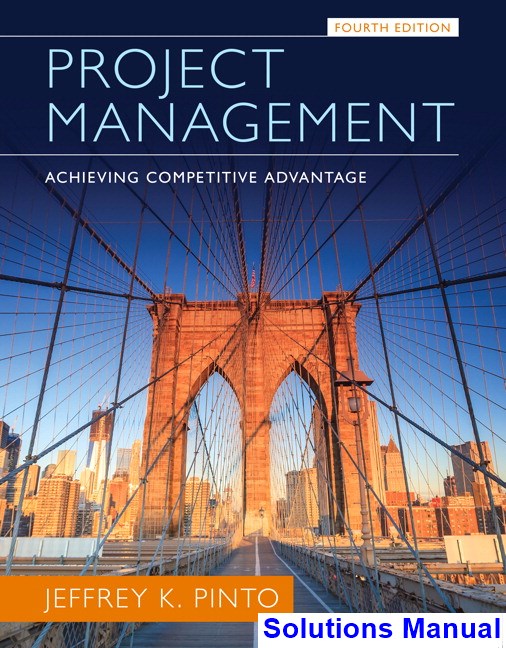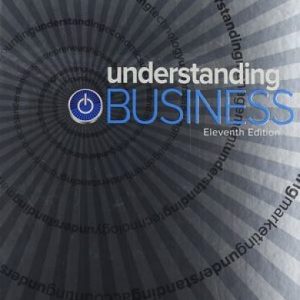This is completed downloadable of Project Management Achieving Competitive Advantage 4th Edition Pinto Solutions Manual

Product Details:
- ISBN-10 : 0133798070
- ISBN-13 : 978-0133798074
- Author:
In its Fourth Edition, Project Management: Achieving Competitive Advantage takes a contemporary, decisive, and business-oriented approach to teaching and learning project management. Blending current theory, contemporary case studies, and hands-on practice and research, Project Management offers students a full range of perspectives of the project management process.
To promote a comprehensive, multi-industry understanding of the text, the author addresses project management theory within the context of a variety of successful organizations, whether they be publicly held, private, or nonprofit. Comprehensive case analysis and detailed exercises give students the tools to assess projects in real-time, equipping them with razor-sharp decision-making skills. Leveraging the latest project management technology, Project Management features just the right balance of real-world examples, cutting-edge theory, and practical exercises.
Table of Content:
- 1.1 What Is a Project?
- General Project Characteristics
- 1.2 Why Are Projects Important?
- Project Profile: “Throwing Good Money after Bad”: the BBC’s Digital Media Initiative
- 1.3 Project Life Cycles
- Box 1.1: Project Managers in Practice
- 1.4 Determinants of Project Success
- Box 1.2: Project Management Research in Brief
- 1.5 Developing Project Management Maturity
- 1.6 Project Elements and Text Organization
- Summary
- Key Terms
- Discussion Questions
- Case Study 1.1 MegaTech, Inc.
- Case Study 1.2 The IT Department at Hamelin Hospital
- Case Study 1.3 Disney’s Expedition Everest
- Case Study 1.4 Rescue of Chilean Miners
- Internet Exercises
- PMP Certification Sample Questions
- Notes
- The Organizational Context: Strategy, Structure, and Culture
- Project Profile: Tesla’s $5 Billion Gamble
- Introduction
- 2.1 Projects and Organizational Strategy
- 2.2 Stakeholder Management
- Identifying Project Stakeholders
- Managing Stakeholders
- 2.3 Organizational Structure
- 2.4 Forms of Organizational Structure
- Functional Organizations
- Project Organizations
- Matrix Organizations
- Moving to Heavyweight Project Organizations
- Box 2.1: Project Management Research in Brief
- 2.5 Project Management Offices
- 2.6 Organizational Culture
- How Do Cultures Form?
- Organizational Culture and Project Management
- Project Profile: Electronic Arts and the Power of Strong Culture in Design Teams
- Summary
- Key Terms
- Discussion Questions
- Case Study 2.1 Rolls-Royce Corporation
- Case Study 2.2 Classic Case: Paradise Lost—The Xerox Alto
- Case Study 2.3 Project Task Estimationand the Culture of “Gotcha!”
- Case Study 2.4 Widgets ’R Us
- Internet Exercises
- PMP Certification Sample Questions
- Integrated Project—Building Your Project Plan
- Notes
- Project Selection and Portfolio Management
- Project Profile: Project Selection Procedures: A Cross-Industry Sampler
- Introduction
- 3.1 Project Selection
- 3.2 Approaches to Project Screening and Selection
- Method One: Checklist Model
- Method Two: Simplified Scoring Models
- Limitations of Scoring Models
- Method Three: The Analytical Hierarchy Process
- Method Four: Profile Models
- 3.3 Financial Models
- Payback Period
- Net Present Value
- Discounted Payback
- Internal Rate of Return
- Choosing a Project Selection Approach
- Project Profile: Project Selection and Screening at GE: The Tollgate Process
- 3.4 Project Portfolio Management
- Objectives and Initiatives
- Developing a Proactive Portfolio
- Keys to Successful Project Portfolio Management
- Problems in Implementing Portfolio Management
- Summary
- Key Terms
- Solved Problems
- Discussion Questions
- Problems
- Case Study 3.1 Keflavik Paper Company
- Case Study 3.2 Project Selection at Nova Western, Inc.
- Internet Exercises
- Notes
- Leadership and the Project Manager
- Project Profile: Leading by Example for the London Olympics—Sir John Armitt
- Introduction
- 4.1 Leaders Versus Managers
- 4.2 How the Project Manager Leads
- Acquiring Project Resources
- Motivating and Building Teams
- Having a Vision and Fighting Fires
- Communicating
- Box 4.1: Project Management Research in Brief
- 4.3 Traits of Effective Project Leaders
- Conclusions about Project Leaders
- Project Profile: Dr. Elattuvalapil Sreedharan, India’s Project Management Guru
- 4.4 Project Champions
- Champions—Who Are They?
- What Do Champions Do?
- How to Make a Champion
- 4.5 The New Project Leadership
- Box 4.2: Project Managers in Practice
- Project Profile: The Challenge of Managing Internationally
- 4.6 Project Management Professionalism
- Summary
- Key Terms
- Discussion Questions
- Case Study 4.1 In Search of Effective Project Managers
- Case Study 4.2 Finding the Emotional Intelligence to Be a Real Leader
- Case Study 4.3 Problems with John
- Internet Exercises
- PMP Certification Sample Questions
- Notes
- Scope Management
- Project Profile: “We look like fools.”—Oregon’s Failed Rollout of Its Obamacare Web Site
- Introduction
- 5.1 Conceptual Development
- The Statement of Work
- The Project Charter
- Project Profile: Statements of Work: Then and Now
- 5.2 The Scope Statement
- The Work Breakdown Structure
- Purposes of the Work Breakdown Structure
- The Organization Breakdown Structure
- The Responsibility Assignment Matrix
- 5.3 Work Authorization
- Project Profile: Defining a Project Work Package
- 5.4 Scope Reporting
- Box 5.1: Project Management Research in Brief
- 5.5 Control Systems
- Configuration Management
- 5.6 Project Closeout
- Summary
- Key Terms
- Discussion Questions
- Problems
- Case Study 5.1 Boeing’s Virtual Fence
- Case Study 5.2 California’s High-Speed Rail Project
- CaseStudy 5.3 Project Management at Dotcom.com
- Case Study 5.4 The Expeditionary Fighting Vehicle
- Internet Exercises
- PMP Certification Sample Questions
- MS Project Exercises
- Appendix 5.1: Sample Project Charter
- Integrated Project—Developing the Work Breakdown Structure
- Notes
- Project Team Building, Conflict, and Negotiation
- Project Profile: Engineers Without Borders: Project Teams Impacting Lives
- Introduction
- 6.1 Building the Project Team
- Identify Necessary Skill Sets
- Identify People Who Match the Skills
- Talk to Potential Team Members and Negotiate with Functional Heads
- Build in Fallback Positions
- Assemble the Team
- 6.2 Characteristics of Effective Project Teams
- A Clear Sense of Mission
- A Productive Interdependency
- Cohesiveness
- Trust
- Enthusiasm
- Results Orientation
- 6.3 Reasons Why Teams Fail
- Poorly Developed or Unclear Goals
- Poorly Defined Project Team Roles and Interdependencies
- Lack of Project Team Motivation
- Poor Communication
- Poor Leadership
- Turnover Among Project Team Members
- Dysfunctional Behavior
- 6.4 Stages in Group Development
- Stage One: Forming
- Stage Two: Storming
- Stage Three: Norming
- Stage Four: Performing
- Stage Five: Adjourning
- Punctuated Equilibrium
- 6.5 Achieving Cross-functional Cooperation
- Superordinate Goals
- Rules and Procedures
- Physical Proximity
- Accessibility
- Outcomes of Cooperation: Task and Psychosocial Results
- 6.6 Virtual Project Teams
- Project Profile: Tele-Immersion Technology Eases the Useof Virtual Teams
- 6.7 Conflict Management
- What Is Conflict?
- Sources of Conflict
- Methods for Resolving Conflict
- 6.8 Negotiation
- Questions to Ask Prior to the Negotiation
- Principled Negotiation
- Invent Options for Mutual Gain
- Insist on Using Objective Criteria
- Summary
- Key Terms
- Discussion Questions
- Case Study 6.1 Columbus Instruments
- Case Study 6.2 The Bean Counterand the Cowboy
- Case Study 6.3 Johnson & Rogers Software Engineering, Inc.
- Exercise in Negotiation
- Internet Exercises
- PMP Certification Sample Questions
- Notes
- Risk Management
- Project Profile: The Building that Melted Cars
- Introduction
- Box 7.1: Project Managers in Practice
- 7.1 Risk Management: a Four-Stage Process
- Risk Identification
- Project Profile: Bank of America Completely Misjudges Its Customers
- Risk Breakdown Structures
- Analysis of Probability and Consequences
- Risk Mitigation Strategies
- Use of Contingency Reserves
- Other Mitigation Strategies
- Control and Documentation
- Project Profile: Collapse of Shanghai Apartment Building
- 7.2 Project Risk Management: An Integrated Approach
- Summary
- Key Terms
- Solved Problem
- Discussion Questions
- Problems
- Case Study 7.1 Classic Case: deHavilland’s Falling Comet
- Case Study 7.2 The Spanish Navy Pays Nearly $3 Billion for a Submarine That Will Sink Like a Stone
- Case Study 7.3 Classic Case: Tacoma Narrows Suspension Bridge
- Internet Exercises
- PMP Certification Sample Questions
- Integrated Project—Project Risk Assessment
- Notes
- Cost Estimation and Budgeting
- Project Profile: Sochi Olympics—What’s the Cost of National Prestige?
- 8.1 Cost Management
- Direct Versus Indirect Costs
- Recurring Versus Nonrecurring Costs
- Fixed Versus Variable Costs
- Normal Versus Expedited Costs
- 8.2 Cost Estimation
- Learning Curves in Cost Estimation
- Box 8.1: Project Management Research in Brief
- Problems with Cost Estimation
- Box 8.2: Project Management Research in Brief
- 8.3 Creating a Project Budget
- Top-Down Budgeting
- Bottom-Up Budgeting
- Activity-Based Costing
- 8.4 Developing Budget Contingencies
- Summary
- Key Terms
- Solved Problems
- Discussion Questions
- Problems
- Case Study 8.1 The Hidden Costs of Infrastructure Projects—The Case of Building Dams
- Case Study 8.2 Boston’s Central Artery/Tunnel Project
- Internet Exercises
- PMP Certification Sample Questions
- Integrated Project—Developing the Cost Estimates and Budget
- Notes
- Project Scheduling: Networks, Duration Estimation, and Critical Path
- Project Profile: After 20 Years and More Than $50 Billion, Oil is No Closer to the Surface: The Casp
- Introduction
- 9.1 Project Scheduling
- 9.2 Key Scheduling Terminology
- 9.3 Developing a Network
- Labeling Nodes
- Serial Activities
- Concurrent Activities
- Merge Activities
- Burst Activities
- 9.4 Duration Estimation
- 9.5 Constructing the Critical Path
- Calculating the Network
- The Forward Pass
- The Backward Pass
- Probability of Project Completion
- Laddering Activities
- Hammock Activities
- Options for Reducing the Critical Path
- Box 9.1: Project Management Research in Brief
- Summary
- Key Terms
- Solved Problems
- Discussion Questions
- Problems
- Internet Exercises
- MS Project Exercises
- PMP Certification Sample Questions
- Notes
- Project Scheduling: Lagging, Crashing, and Activity Networks
- Project Profile: Enlarging the Panama Canal
- Introduction
- 10.1 Lags in Precedence Relationships
- Finish to Start
- Finish to Finish
- Start to Start
- Start to Finish
- 10.2 Gantt Charts
- Adding Resources to Gantt Charts
- Incorporating Lags in Gantt Charts
- Box 10.1: Project Managers in Practice
- 10.3 Crashing Projects
- Options for Accelerating Projects
- Crashing the Project: Budget Effects
- 10.4 Activity-on-Arrow Networks
- How Are They Different?
- Dummy Activities
- Forward and Backward Passes with AOA Networks
- AOA Versus AON
- 10.5 Controversies in the Use of Networks
- Conclusions
- Summary
- Key Terms
- Solved Problems
- Discussion Questions
- Problems
- Case Study 10.1 Project Scheduling at Blanque Cheque Construction (A)
- Case Study 10.2 Project Scheduling at Blanque Cheque Construction (B)
- MS Project Exercises
- PMP Certification Sample Questions
- Integrated Project—Developing the Project Schedule
- Notes
- Advanced Topics in Planning and Scheduling: Agile and Critical Chain
- Project Profile: Developing Projects Through Kickstarter—Do Delivery Dates Mean Anything?
- Introduction
- 11.1 Agile Project Management
- What Is Unique About Agile PM?
- Tasks Versus Stories
- Key Terms in Agile PM
- Steps in Agile
- Sprint Planning
- Daily Scrums
- The Development Work
- Sprint Reviews
- Sprint Retrospective
- Problems with Agile
- Box 11.1: Project Management Research in Brief
- 11.2 Extreme Programming (XP)
- 11.3 the Theory of Constraints and Critical Chain Project Scheduling
- 11.4 the Critical Chain Solution to Project Scheduling
- Developing the Critical Chain Activity Network
- Critical Chain Solutions Versus Critical Path Solutions
- Project Profile: Eli Lilly Pharmaceuticals and Its Commitment to Critical Chain Project Management
- 11.5 Critical Chain Solutions to Resource Conflicts
- 11.6 Critical Chain Project Portfolio Management
- Box 11.2: Project Management Research in Brief
- 11.7 Critiques of CCPM
- Summary
- Key Terms
- Solved Problem
- Discussion Questions
- Problems
- Case Study 11.1 It’s an Agile World
- Case Study 11.2 Ramstein Products, Inc.
- Internet Exercises
- Notes
- Resource Management
- Project Profile: Hong Kong Connects to the World’s Longest Natural Gas Pipeline
- Introduction
- 12.1 The Basics of Resource Constraints
- Time and Resource Scarcity
- 12.2 Resource Loading
- 12.3 Resource Leveling
- Step One: Develop the Resource-Loading Table
- Step Two: Determine Activity Late Finish Dates
- Step Three: Identify Resource Overallocation
- Step Four: Level the Resource-Loading Table
- 12.4 Resource-Loading Charts
- Box 12.1: Project Managers in Practice
- 12.5 Managing Resources in Multiproject Environments
- Schedule Slippage
- Resource Utilization
- In-Process Inventory
- Resolving Resource Decisions in Multiproject Environments
- Summary
- Key Terms
- Solved Problem
- Discussion Questions
- Problems
- Case Study 12.1 The Problems of Multitasking
- Internet Exercises
- MS Project Exercises
- PMP Certification Sample Questions
- Integrated Project—Managing Your Project’s Resources
- Notes
- Project Evaluation and Control
- Project Profile: New York City’s City Time Project
- Introduction
- 13.1 Control Cycles—a General Model
- 13.2 Monitoring Project Performance
- The Project S-Curve: A Basic Tool
- S-Curve Drawbacks
- Milestone Analysis
- Problems with Milestones
- The Tracking Gantt Chart
- Benefits and Drawbacks of Tracking Gantt Charts
- 13.3 Earned Value Management
- Terminology for Earned Value
- Creating Project Baselines
- Why Use Earned Value?
- Steps in Earned Value Management
- Assessing a Project’s Earned Value
- 13.4 Using Earned Value to Manage a Portfolio of Projects
- Project Profile: Earned Value at Northrop Grumman
- 13.5 Issues in the Effective Use of Earned Value Management
- 13.6 Human Factors in Project Evaluation and Control
- Critical Success Factor Definitions
- Conclusions
- Summary
- Key Terms
- Solved Problem
- Discussion Questions
- Problems
- Study 13.1 The IT Department at Kimble College
- Case Study 13.2 The Superconducting Supercollider
- Case Study 13.3 Boeing’s 787 Dreamliner: Failure to Launch
- Internet Exercises
- MS Project Exercises
- PMP Certification Sample Questions
- Appendix 13.1: Earned Schedule*
- Notes
- Project Closeout and Termination
- Project Profile: Duke Energy and Its Cancelled Levy County Nuclear Power Plant
- Introduction
- 14.1 Types of Project Termination
- Box 14.1: Project Managers in Practice
- 14.2 Natural Termination—the Closeout Process
- Finishing the Work
- Handing Over the Project
- Gaining Acceptance for the Project
- Harvesting the Benefits
- Reviewing How It All Went
- Putting It All to Bed
- Disbanding the Team
- What Prevents Effective Project Closeouts?
- 14.3 Early Termination for Projects
- Making the Early Termination Decision
- Project Profile: Aftermath of a “Feeding Frenzy”: Dubai and Cancelled Construction Projects
- Shutting Down the Project
- Box 14.2: Project Management Research in Brief
- Allowing for Claims and Disputes
- 14.4 Preparing the Final Project Report
- Conclusion
- Summary
- Key Terms
- Discussion Questions
- Case Study 14.1 New Jersey Kills Hudson River Tunnel Project
- Case Study 14.2 The Project That Wouldn’t Die
- Case Study 14.3 The Navy Scraps Development of Its Showpiece Warship—Until the Next Bad Idea
- Internet Exercises
- PMP Certification Sample Questions
- Appendix 14.1: Sample Pages from Project Sign-off Document
- Notes
- Appendix A The Cumulative Standard Normal Distribution
- Appendix B Tutorial for MS Project 2013
- Appendix C Project Plan Template
- Glossary
- Company Index
- Name Index
- Subject Index





